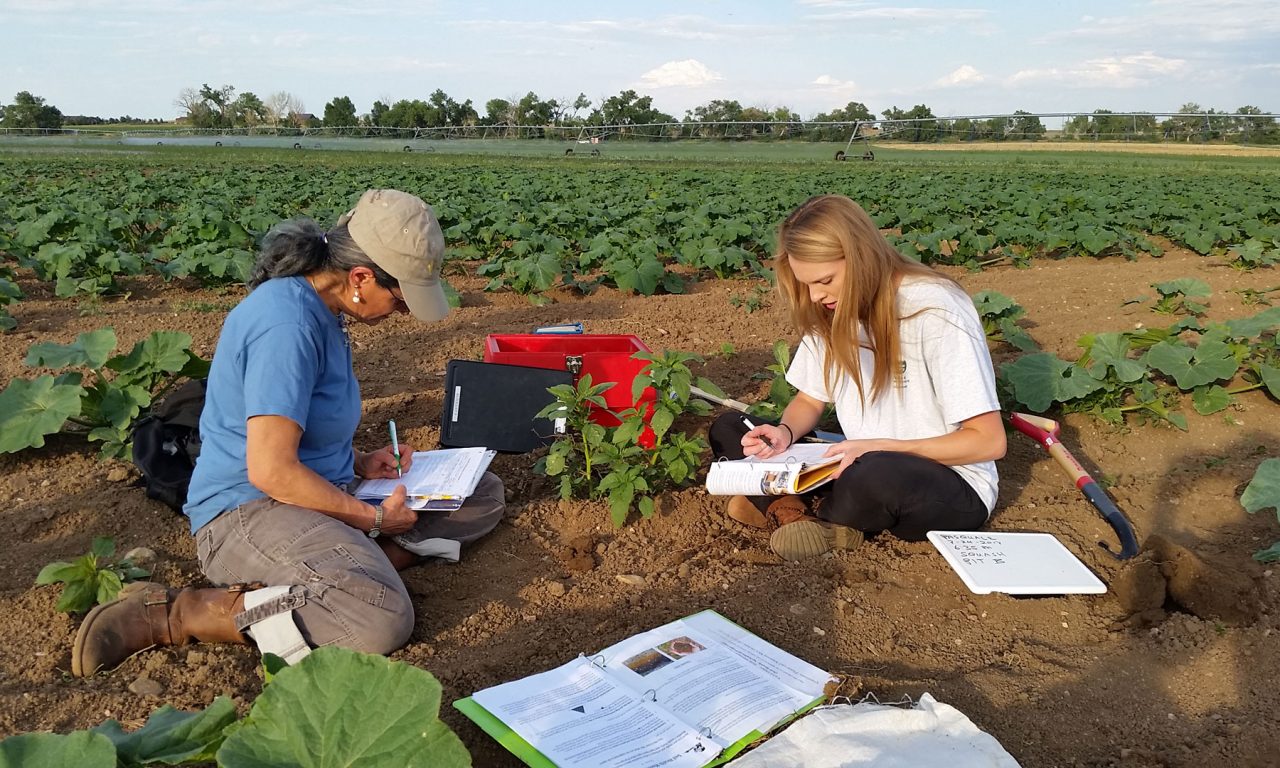Boulder County Parks and Open Space is committed to conserving natural, cultural, and agricultural resources, and providing public uses that reflect sound resource management and community values. One of the most fundamental natural resources is right beneath our feet. Soil is a living and life-giving natural resource vital to our survival.
Soil health can be defined as the continued capacity of soil to function as a vital living ecosystem that sustains life and is regenerated by the management of plants and animals by humans.
Benefits of Soil Health Management
With the adoption of the Boulder County Cropland Policy in 2011, the Boulder County Parks and Open Space (BCPOS) Agricultural Resources Division was prompted to initiate a soil health monitoring program on county-owned and privately-operated agricultural lands. In 2014, BCPOS began a partnership with the USDA-Natural Resource Conservation Service (NRCS) in this endeavor. NRCS was a logical partner because of their technical expertise in the science of soil health, and history of working with land managers to establish a conservation plan to manage natural resources. The objective of the soil health monitoring program is to bring a heightened awareness of the benefits of managing agricultural lands within the context of soil health management systems (SHMS) to policy makers, tenants and concerned citizens in Boulder County. SHMS are farming systems that use a combination of conservation practices to address resource concerns such as erosion, soil quality degradation, and insufficient water. Conservation practices such as residue and tillage management, conservation crop rotations, cover crops and prescribed grazing are used in combination to address documented resource concerns.
The long-term health of agricultural soils is a major determining factor in how successful Boulder County will be in creating a sustainable agricultural system on its cropland. Sustainability as it relates to soil health and quality requires affirmative efforts to protect the resource base of cropland so that it shall be productive in the future.
During 2014 and 2015, the Agricultural Resources Division assessed six characteristics of soil health on eight properties. These characteristics included, soil texture, water infiltration, organic matter estimates, percent residue cover, aggregate stability and an earthworm count.
Technical assistance from the NRCS allowed staff to reassess and slightly redesign and expand the program in 2016. The redesigned program included a more robust field assessment and two laboratory tests to assess soil health. The assessments were completed by a team of volunteers, BCPOS, CSU Extension, and NRCS staff members.
Results of the field Resource Concern Assessments are below. Scores are on a scale of one to three with three being the highest or best. Soil in the Soil Texture row: C-Clay, L-Loam, S-Sand, SI-Silt.
| Characteristic Type | Characteristic | Property 1 | Property 2 | Property 3 | Property 4 | Property 5 | Property 6 | Property 7 | Property 8 |
|---|---|---|---|---|---|---|---|---|---|
| Soil Texture (field) |
SIC, SC, C | SICL, SCL | CL | CL, SCL | SCL, SICL | SL, SCL | CL, L, SCL | SICL | |
|
PHYSICAL
|
Erosion | 2.3 | 3.0 | 3.0 | 3.0 | 2.7 | 3.0 | 1.9 | 3.0 |
| Soil Structure | 1.3 | 2.5 | 1.5 | 2.0 | 2.0 | 1.7 | 1.5 | 2.0 | |
| Slake Test (aggregate stability NRCS) |
2.0 | N/A | 2.5 | 2.0 | 2.5 | 1.0 | N/A | N/A | |
| Soil Crust | 1.0 | 2.8 | 2.3 | 1.0 | 1.5 | 2.5 | 1.5 | 3.0 | |
| Compaction | 1.0 | 2.0 | 2.1 | 1.3 | 2.2 | 1.3 | 1.0 | 1.0 | |
|
BIOLOGICAL
|
Residue | 2.0 | 2.5 | 2.0 | 2.3 | 3.0 | 2.7 | 1.5 | 3.0 |
| Roots & pores | 1.3 | 2.5 | 2.0 | 1.7 | 1.5 | 1.5 | 1.5 | 2.0 | |
| Soil color & smell | 1.2 | 2 | 2.0 | 2.0 | 2.0 | 1.3 | 1.5 | 2.0 | |
| Soil Food Web | 1.0 | 2.75 | 2.0 | 2.4 | 1.9 | 1.3 | 1.3 | 2.0 | |
| Soil Temperature | 1.0 | 3 | 1.0 | 3.0 | 1.0 | 2.3 | 2.7 | 2.0 | |
| Health Field Score | 1.4 | 2.3 | 2.0 | 2.1 | 2.0 | 1.9 | 1.4 | 2.0 | |
Two laboratory tests were also completed on three of the eight properties. Ward Laboratories performed the Haney Test (also known as the Soil Health Nutrient Tool) and Cornell University performed the Comprehensive Assessment of Soil Health (CASH). Haney scores range from one to 50, with a score of seven or higher preferred. CASH scores range from one to 100 where higher scores are better. The combined results of the field assessment, Haney Test and CASH are shown below. The same trend was revealed providing similar diagnoses of the systems’ soil health. Dig a little, learn a lot!
Combined Soil Health Results
| Score Type | Property 1 | Property 6 | Property 2 |
|---|---|---|---|
| Field Score | 1.4 | 1.9 | 2.3 |
| CASH Score | 36 | 39 | 52 |
| Haney Score | 3.91 | 5.37 | 10.2 |
The goal when assessing soil health is not to compare one property to another. The goal is to compare each property to itself as management practices change over time. The partnership created between BCPOS, NRCS, CSU Extension, tenants and volunteers has led to exciting collaborations and projects that have continued in 2017.
Stay tuned for part two in the Spring 2018 issue of Images.


